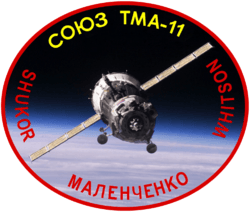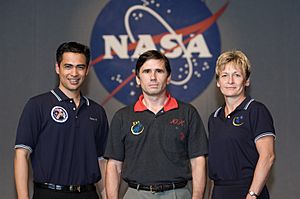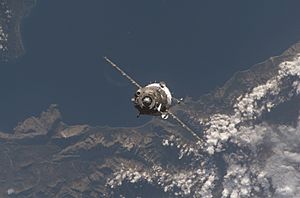Soyuz TMA-11 facts for kids
 |
|
| Operator | Roskosmos |
|---|---|
| Mission duration | 191 days, 19 hours, 17 minutes |
| Spacecraft properties | |
| Spacecraft type | Soyuz-TMA 11F732 |
| Manufacturer | RKK Energia |
| Crew | |
| Crew size | 3 |
| Members | Yuri Malenchenko Peggy A. Whitson |
| Launching | Sheikh Muszaphar Shukor |
| Landing | Yi So-Yeon |
| Start of mission | |
| Launch date | October 10, 2007, 13:22:39 UTC |
| Rocket | Soyuz-FG |
| Launch site | Baikonur 1/5 |
| End of mission | |
| Landing date | April 19, 2008, 08:30 UTC |
| Orbital parameters | |
| Reference system | Geocentric |
| Regime | Low Earth |
| Inclination | 51.6 degrees |
| Docking with ISS | |
| Docking port | Zarya |
| Docking date | 12 October 2007 14:50 UTC |
| Undocking date | 19 April 2008 05:06 UTC |
| Time docked | 189d 14h 16m |
  From left to right: Sheikh Muszaphar Shukor, Yuri Malenchenko, Peggy Whitson Soyuz programme
(Crewed missions) |
|
Soyuz TMA-11 was a human spaceflight mission using a Soyuz-TMA spacecraft to transport personnel to and from the International Space Station (ISS). The mission began at 13:22 UTC on October 10, 2007, when the spacecraft was launched from the Baikonur Cosmodrome by a Soyuz FG launch vehicle. It brought to the station two members of the ISS Expedition 16 crew, as well as Sheikh Muszaphar, the first Malaysian in space. TMA-11 remained at the station as an escape craft, and returned safely to Earth on April 19, 2008, after it had been replaced by Soyuz TMA-12. Although the vehicle landed safely, it suffered a partial separation failure which caused a ballistic re-entry that in turn caused it to land 475 km from the intended landing point.
Crew
| Position | Launching crew | Landing crew |
|---|---|---|
| Commander | Expedition 16 Fourth spaceflight |
|
| Flight Engineer | Expedition 16 Second spaceflight |
|
| Spaceflight Participant | Only spaceflight |
Only spaceflight |
Backup crew
| Position | Launching crew | Landing crew |
|---|---|---|
| Commander | ||
| Flight Engineer | ||
| Spaceflight Participant | ||
Mission highlights
The launch, which took place at 13:22 UTC (5:22 p.m. Moscow time) on October 10, 2007, "Went off successfully and without a hitch" according to a Russian official. In Malaysia, crowds in the capital city of Kuala Lumpur cheered as they watched the live launch broadcast on television sets in Dataran Merdeka (Independence Square). The giant screen originally set up for this purpose failed to function properly.
The Soyuz TMA-11 docking to the ISS occurred at 14:50 UTC on October 12, 2007.
Ballistic reentry
The spacecraft landed in Kazakhstan on April 19, 2008. Similar to Soyuz TMA-1 / Expedition 6 and Soyuz TMA-10 / Expedition 15, the Soyuz performed a ballistic reentry, a reentry steeper than a normal reentry, due to a malfunction and landed 475 km from the intended landing point. This was the second such event in a row for Soyuz TMA. Although the crew were recovered with no serious injuries, the spacecraft's hatch and antenna suffered burn damage during the unusual reentry. Yi So-yeon was hospitalized after her return to South Korea due to injuries caused by the rough return voyage in the Soyuz TMA-11 spacecraft. The South Korean Science Ministry stated that the astronaut had a minor injury to her neck muscles and had bruised her spinal column. The Russian news agency Interfax reported the ship may have entered the atmosphere hatch-first.
Anatoly Perminov, the head of the Russian Federal Space Agency, speculated that the ballistic reentry was connected to a Russian nautical superstition that having more women than men on a craft was unlucky. The return flight of Soyuz TMA-11 was the first time two women flew together on board a Soyuz and it was the first time women outnumbered men aboard a spacecraft since Valentina Tereshkova's solo flight in 1963. "This isn't discrimination," Perminov stated when challenged on the point. "I'm just saying that when a majority [of the crew] is female, sometimes certain kinds of unsanctioned behaviour or something else occurs." Perminov said he would try to ensure that the number of women would not exceed the number of men in the future.
On May 24, 2008, Perminov announced the results of the investigation into the malfunction. The principal reason for the unusual re-entry was failure of the service module to separate normally as a result of one of five pyro-bolts malfunctioning. The root cause of the failure was not definitively determined, but the Russian investigation concluded that long-term exposure to the electrical environment surrounding the ISS may have damaged the firing system. A similar anomaly occurred during the re-entry of Soyuz 5 in 1969.
See also
 In Spanish: Soyuz TMA-11 para niños
In Spanish: Soyuz TMA-11 para niños


